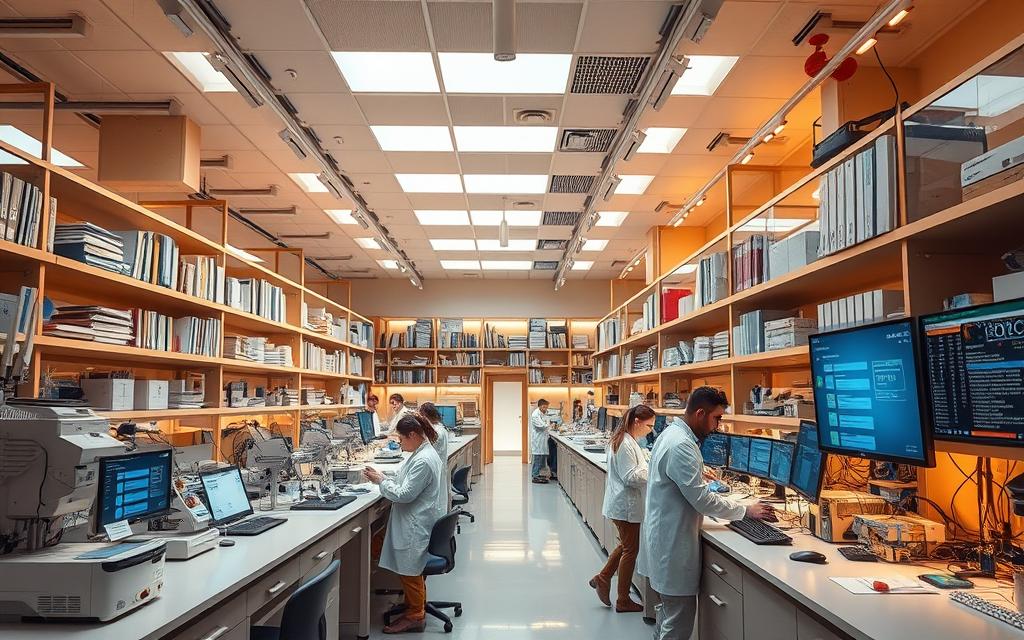What makes some innovations truly groundbreaking? MIT researchers say it’s science-based technology that tackles big challenges. These challenges have technological uncertainty, meaning outcomes and timelines are not set. They need years of hard work, often taking 7-10 years to develop, as Boston Consulting Group found.
Unlike usual tech upgrades, these innovations create new markets. Moderna’s mRNA platform is a great example. It uses decades of research in molecular biology, not just software updates. These projects need a lot of R&D investment, much more than apps or e-commerce.
There are three key signs of these ventures:
1. Solutions based on scientific discoveries
2. High-risk development with unclear paths
3. The chance to change whole sectors with new breakthroughs
Quantum computing and synthetic biology show the mix of risk and chance. Investors and leaders are now focusing on these areas. They see their power to tackle big issues like climate change and better healthcare.
What Constitutes Deep Tech?
Deep tech ventures are different from regular tech advancements. They blend science and engineering in new ways. These innovations need deep research and often change whole industries.
Defining Deep Tech Innovation
Deep tech stands out for its scientific rigour. It’s not just about making things better. Instead, it comes from lab research and peer-reviewed studies.
Scientific foundations vs incremental improvements
CRISPR gene-editing is a great example. It’s not just a small step forward in biotech. It took 10 years of work in microbiology, chemistry, and computing.
Time horizons and capital requirements
Deep tech projects need 10-15 years of funding. Quantum computing shows this, with IBM aiming for commercial use by 2035 after decades of work.
Historical Context of Deep Tech Development
From ENIAC to today’s quantum processors, tech has grown. Governments often lead in starting this research.
From ENIAC to quantum supremacy
ENIAC was huge and used vacuum tubes in 1946. Now, quantum systems are tiny and use nanotechnology. This shows how tech gets more complex and expensive over time.
DARPA’s role in foundational research
DARPA has led in risky research. In the 1960s, it funded packet switching, key to the internet. This shows how public money helps early-stage tech.
Key Characteristics of Deep Tech Solutions
Deep tech ventures face unique challenges. MIT has a framework that highlights the importance of managing technical risks.
High technical risk profiles
MIT studied 400 biotech ventures. They found only 3.4% of oncology trials succeed. This shows why managing technical risks is key to success.
Cross-disciplinary implementation challenges
AI-optimised drug discovery shows the need for teamwork. It requires biostatisticians, regulatory experts, and machine learning engineers to work together. This is a big challenge for many industries.
Differentiating Deep Tech from Conventional Technologies
Deep tech and conventional technologies both push progress forward. But they differ in how they develop and affect markets. A 2018 BCG study found deep tech investments hit $18 billion, showing its big impact.
This section looks at the main differences through three key areas.
High-Tech vs Deep Tech: Critical Distinctions
High-tech, like new smartphones, has a set timeline. Apple’s iPhone updates are a good example. But deep tech, like QuantumScape’s battery, takes much longer, over 10 years.
Market readiness comparisons
Consumer tech usually hits the market in 2-3 years. But deep tech, like nuclear fusion, takes a decade or more. This affects how funding and partnerships work.
Investment recovery timelines
Investors in regular tech expect returns in 5 years. But deep tech, like CRISPR, needs more time, 7-12 years. This is why deep tech needs patient capital.
| Factor | High-Tech | Deep Tech |
|---|---|---|
| Prototype to Market | 1-3 years | 5-15 years |
| ROI Expectation | 3-5 years | 7-12 years |
| Failure Rate | 35-50% | 60-80% |
The Patent Landscape in Deep Tech
Intellectual property strategies vary a lot. ARM Holdings made mobile computing open-source. But Tesla keeps its battery patents tight.
Molecular manufacturing faces big challenges with patent thickets. These are when many patents overlap, slowing progress.
IP strategies for molecular manufacturing
Companies like DNA Script use defensive patenting. This protects their breakthroughs in oligonucleotide synthesis. It balances protection with the need to collaborate in biotech.
Open-source vs proprietary model tensions
The Linux Foundation’s ELISA project shows open-source AI safety can speed up development. But fusion energy startups often choose to keep their tech secret to get funding.
Commercialisation Pathways
MIT’s The Engine fund is a great example of deep tech commercialisation. It mixes academic research with scaling up. Their companies get an average of $23 million in early funding, much more than SaaS startups.
University spin-out success factors
Good tech transfer offices are key. Stanford’s Office of Technology Licensing has helped launch 1,200+ companies, including Google. Success factors include:
- Early industry partnerships
- SBIR funding programme participation
- Clear regulatory roadmaps
Public-private partnership models
The US Department of Energy’s Advanced Research Projects invest $3.5 billion a year through 62 national labs. Their model helps reduce risk for private sector partners in grid-scale storage by 40-60%.
Core Technological Pillars
Modern deep tech innovations are built on three key areas: artificial intelligence, quantum computing, and materials science. These fields are changing industries and solving big problems. They’re making materials that can withstand harsh conditions and developing algorithms that can predict diseases.
Artificial Intelligence Frontiers
MIT’s 2022 study on neuromorphic computing architectures changed the game in edge AI. Their liquid neural networks, inspired by the brain, showed 98% accuracy in drone navigation. This is a big step forward in making AI systems more energy-efficient.
Explainable AI in medical diagnostics
MIT’s work on interpretable machine learning is key for healthcare. Their “glass-box” algorithms help doctors understand cancer detection systems. This makes it easier for them to trust AI-assisted diagnoses, as shown in recent medical research.
Quantum Computing Breakthroughs
IBM’s 127-qubit Eagle processor shows both progress and challenges. It achieved quantum supremacy in financial modelling but faces qubit stability challenges. The system can only keep coherence for 70 microseconds at very cold temperatures.
Post-quantum cryptography needs
As quantum systems get better, lattice-based cryptography becomes more important. The US National Institute of Standards chose four lattice-based algorithms for standardisation in 2024. They expect quantum computers to break RSA encryption in about 15 years.
Advanced Materials Science
Haydale’s method for making plasma-functionalised graphene has a 90% yield rate. This is much better than traditional CVD synthesis methods. It could lead to mass production of graphene-enhanced batteries by 2026.
Self-healing polymer applications
Loctite’s aerospace polymers can recover 82% of their strength after being damaged. They use microcapsules that release healing agents when stressed. This could extend the life of satellite components by 3-5 years.
Sector-Specific Implementations
Deep tech innovations are changing whole industries. They are making big impacts in healthcare, energy, and space. Each area is using new tech to solve big problems in new ways.
Transforming Medical Frontiers
The healthcare sector has seen huge breakthroughs with CRISPR gene-editing tools. Vertex Pharmaceuticals got approval for a CRISPR-based therapy for sickle-cell anaemia. This is the first to change faulty genes in blood cells.
This could change how we treat over 7,000 genetic disorders.
Organ-on-chip drug testing platforms
Companies like Emulate are using human cell-based microchips for drug testing. Their liver-chip is 87% accurate in predicting drug toxicity. This speeds up drug development and reduces animal testing.
Over 350 pharmaceutical programmes are now using this technology.
Powering Sustainable Energy Systems
MIT researchers and Commonwealth Fusion Systems are working on tokamak reactors. They use high-temperature superconductors. Their SPARC prototype aims to start plasma by 2025, aiming for commercial fusion energy by 2030.
This could give us limitless clean power without radioactive waste.
Solid-state battery innovations
Companies like QuantumScape are improving on traditional lithium-ion batteries. They use ceramic separators. Early tests show 80% capacity after 800 cycles, a big step towards 500-mile EV ranges.
Big manufacturers plan to start making these batteries in 2026.
Advancing Extraterrestrial Capabilities
SpaceX’s Raptor engines have been reused 40 times per booster. They use advanced cooling systems. Varda Space Industries is working on orbital manufacturing.
They successfully made fibre optics in microgravity during their 2023 mission.
In-situ resource utilisation methods
Blue Origin’s ISRU oxygen extraction system can make 1kg of breathable air from 7kg of lunar soil. This supports NASA’s Artemis programme for a sustained moon presence. Recent tests got 94% oxygen purity using simulated regolith.
“Fusion energy’s promise is not just in clean power, but in enabling technologies we can’t yet imagine.”
These examples show deep tech’s power to tackle many challenges at once. From editing DNA to exploring space, today’s solutions will shape tomorrow’s world.
Building Tomorrow’s Innovation Infrastructure
The deep tech world needs a balanced approach. MIT’s 2022 policy framework sets out five key areas for success. These include technical strength, diverse teams, scalable systems, partnerships, and making a societal impact.
NATO’s €1 billion fund for innovation shows the power of working together. It speeds up the development of technologies that can be used for defence and civilian purposes. This model could also boost climate tech in North America and Europe.
Regulatory sandboxes are vital for testing new technologies. MIT researchers suggest creating special areas for experimenting with drones and energy storage. This helps deep tech startups overcome the hurdle of turning ideas into products.
Building a strong talent pipeline is also essential. Collaborations between universities and companies are promising. For example, Caltech and private firms are training experts in photonics and neurotechnology. At the same time, IP reforms are needed to keep innovation flowing.
















